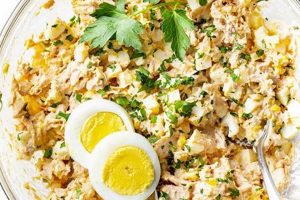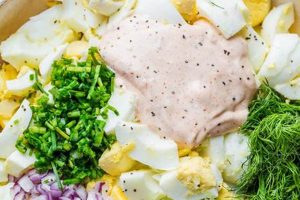A classic dish prepared with cooked eggs, mayonnaise, and various seasonings, this variation omits mustard, catering to those who dislike its sharp flavor or have dietary restrictions. A typical preparation involves chopping hard-boiled eggs and combining them with mayonnaise, salt, pepper, and sometimes other ingredients like celery, onion, or paprika. This creates a creamy, flavorful filling ideal for sandwiches, salads, or deviled eggs.
This mustard-free version offers a milder, sweeter flavor profile, appealing to a wider range of palates. It can be particularly suitable for children or individuals sensitive to strong tastes. Historically, egg salad has been a popular and economical dish, utilizing readily available ingredients. Variations, including those without mustard, have emerged to accommodate individual preferences and dietary needs. This adaptability contributes to the dish’s enduring popularity.
This exploration will delve into specific ingredient choices, step-by-step instructions, and creative serving suggestions for a delicious mustard-free egg salad experience.
Tips for Crafting Delicious Mustard-Free Egg Salad
Achieving a perfect egg salad without mustard requires attention to detail and a few key techniques. These tips offer guidance for creating a flavorful and satisfying dish.
Tip 1: Perfect Hard-Boiled Eggs: Achieving the ideal hard-boiled egg consistency is crucial. Overcooked eggs can result in a dry, crumbly texture and a slightly green ring around the yolk. A properly cooked egg will have a firm, yet tender yolk. Recommended methods include steaming or using a rapid-cooling ice bath after boiling.
Tip 2: Mayonnaise Selection: Mayonnaise serves as the foundation of the salad’s flavor and texture. High-quality mayonnaise contributes a rich, creamy base. Experimenting with different brands or homemade versions allows for customization of the flavor profile.
Tip 3: Enhancing Flavor Without Mustard: The absence of mustard opens opportunities for alternative seasonings. Finely diced red onion or shallots add a pungent bite. Sweet pickle relish introduces a tangy sweetness. Fresh herbs like dill or chives offer a refreshing element. Paprika, celery salt, or a dash of hot sauce can provide additional complexity.
Tip 4: Achieving Optimal Texture: Texture plays a significant role in overall enjoyment. A combination of finely chopped and coarsely chopped eggs creates a more interesting mouthfeel. Alternatively, mashing the eggs completely creates a smoother, creamier consistency.
Tip 5: Ingredient Ratios: Balancing the egg-to-mayonnaise ratio is essential. Too much mayonnaise results in a loose, overly rich salad, while too little can create a dry, crumbly texture. Start with a smaller amount of mayonnaise and adjust to the desired consistency.
Tip 6: Chilling and Serving: Chilling the prepared salad allows the flavors to meld and enhances the overall experience. Serve chilled on bread, crackers, lettuce cups, or as a filling for deviled eggs.
By following these guidelines, one can create a truly exceptional mustard-free egg salad that satisfies even the most discerning palates.
This understanding of essential techniques sets the stage for exploring specific recipes and creative variations.
1. Ingredient Quality
Ingredient quality significantly impacts the final product in a mustard-free egg salad. Given the absence of mustard’s potent flavor, the inherent tastes of the other ingredients become more pronounced. Fresh, high-quality eggs are essential. Farm-fresh eggs, if available, often possess richer yolks and contribute a superior flavor compared to standard supermarket eggs. The mayonnaise also plays a critical role; choosing a high-quality mayonnaise made with real ingredients, rather than one with artificial flavors or preservatives, noticeably elevates the overall taste and texture. For example, using olive oil-based mayonnaise instead of a soybean oil-based version introduces a subtle fruitiness and a smoother texture. Similarly, fresh herbs and spices, as opposed to dried or stale ones, contribute brighter, more vibrant flavors to the salad.
This emphasis on quality extends to other additions. If incorporating vegetables like celery or onion, selecting crisp, fresh produce ensures optimal flavor and texture. Using wilted or older vegetables can introduce off-flavors and detract from the overall quality of the egg salad. The same principle applies to any other supplementary ingredients, such as pickles, capers, or olives. Choosing high-quality versions of these additions ensures that they complement, rather than compromise, the delicate balance of flavors in the absence of mustard.
Prioritizing ingredient quality, therefore, becomes paramount when crafting a mustard-free egg salad. This attentiveness to detail allows the natural flavors of the ingredients to shine through, resulting in a more nuanced and satisfying culinary experience. Overlooking this aspect can result in a bland or unappealing dish, regardless of the chosen recipe or technique. A commitment to quality ingredients ensures a superior final product, showcasing the subtle complexities of this classic dish.
2. Flavor Balance
Flavor balance in a mustard-free egg salad requires careful consideration due to the absence of mustard’s characteristic sharpness. Mustard typically provides a pungent, slightly bitter counterpoint to the richness of mayonnaise and the mildness of eggs. Without it, achieving a harmonious blend of flavors becomes more nuanced, demanding a deeper understanding of complementary and contrasting tastes.
- Acidity:
Acidity plays a crucial role in balancing the richness of mayonnaise. While mustard contributes acidity, its absence necessitates alternative sources. Lemon juice or vinegar provide the necessary brightness, cutting through the fattiness of the mayonnaise and preventing the salad from tasting overly heavy. A small amount of pickle relish can also contribute acidity and a touch of sweetness. The amount of acid should be carefully calibrated to avoid overpowering the other flavors.
- Saltiness:
Salt enhances the flavors of all ingredients. In a mustard-free version, salt becomes even more critical as it helps to bring out the subtle flavors of the eggs and other components. Sea salt or kosher salt is generally preferred for its cleaner taste. It’s essential to season gradually, tasting frequently, to ensure the proper balance is achieved without over-salting.
- Aromatics:
Aromatics contribute complexity and depth of flavor. Finely chopped red onion or shallots offer a subtle pungency that can partially replicate the sharpness of mustard. Fresh herbs such as dill, chives, or parsley provide a refreshing element. A pinch of paprika or cayenne pepper introduces a hint of warmth. The selection and quantity of aromatics should complement the other ingredients without dominating the flavor profile.
- Sweetness:
A touch of sweetness can balance the savory elements and add another layer of complexity. Finely diced sweet pickles or a small amount of finely grated apple or carrot can introduce subtle sweetness without overpowering the other flavors. This element should be used judiciously to avoid creating an overly sweet egg salad.
By carefully balancing these elementsacidity, saltiness, aromatics, and sweetnessone can create a mustard-free egg salad that is not only flavorful but also exhibits a harmonious blend of tastes. Each element contributes to the overall sensory experience, creating a well-rounded and satisfying dish despite the absence of mustard. This nuanced approach to flavor allows for a greater appreciation of the individual ingredients and highlights the versatility of egg salad as a culinary canvas.
3. Texture Variations
Texture variations play a crucial role in the overall enjoyment of egg salad, particularly in a mustard-free version where the absence of mustard’s textural contribution necessitates a more conscious approach to creating a balanced mouthfeel. Manipulating the textures of the core ingredients and incorporating additional elements with varying textures can elevate a simple egg salad from ordinary to exceptional.
- Egg Consistency
The texture of the eggs themselves forms the foundation of the salad’s overall texture. A range of textures can be achieved through different preparation methods. Finely chopping the eggs creates a smoother, more uniform texture, while coarsely chopping them yields a chunkier, more rustic feel. Mashing the eggs results in a creamy, almost paste-like consistency. A combination of chopping and mashing can also be employed to achieve a balanced texture.
- Mayonnaise Incorporation
The amount of mayonnaise used and how it is incorporated affects the final texture. A higher mayonnaise-to-egg ratio results in a creamier, looser salad, whereas a lower ratio yields a denser, more compact texture. The manner in which the mayonnaise is mixed also matters. Gently folding the mayonnaise into the chopped eggs preserves some of the egg’s structural integrity, whereas vigorous mixing creates a more homogenous, emulsified texture.
- Inclusion of Vegetables
Adding vegetables introduces textural contrast and complexity. Finely diced celery or red onion provides a crisp, crunchy counterpoint to the softness of the eggs and mayonnaise. Other vegetables like bell peppers or cucumbers can also be incorporated, offering varying degrees of crunch and juiciness. The size of the vegetable dice influences the perceived texture; smaller dice pieces integrate more seamlessly, while larger pieces provide more pronounced bursts of texture.
- Supplementary Ingredients
Incorporating ingredients like chopped nuts, seeds, or crumbled bacon adds further textural dimensions. Nuts and seeds offer a satisfying crunch and can complement the creamy base of the salad. Crumbled bacon introduces a crispy, savory element. These additions not only enhance the textural profile but also contribute to the overall flavor complexity of the egg salad.
By carefully considering these elementsegg consistency, mayonnaise incorporation, inclusion of vegetables, and supplementary ingredientsone can craft a mustard-free egg salad with a nuanced and satisfying textural profile. A well-executed balance of textures elevates the eating experience, transforming a simple dish into a more complex and enjoyable culinary creation.
4. Creative additions
Creative additions offer a significant opportunity to elevate the flavor profile of egg salad in the absence of mustard. Mustard’s inherent pungency and complexity often mask the subtle flavors of other ingredients. Omitting mustard creates a more neutral palate, allowing for greater experimentation and bolder flavor combinations. This blank canvas encourages culinary exploration, transforming a traditional egg salad into a more personalized and exciting dish. For instance, incorporating ingredients like chopped fresh herbs (dill, chives, tarragon), crumbled feta cheese, or roasted red peppers introduces unique flavor dimensions that might be overwhelmed by mustard’s dominance. Similarly, the addition of chopped apples or grapes provides a contrasting sweetness and textural complexity, while a sprinkle of smoked paprika or curry powder offers a smoky or savory depth. These additions not only enhance the overall taste but also contribute to a more visually appealing and texturally interesting final product.
The strategic use of creative additions also addresses the potential flavor void left by the absence of mustard. While mustard contributes a distinct sharpness and tang, it also acts as a unifying element, binding the other flavors together. Creative additions can fulfill this role by introducing complementary or contrasting flavors that create a balanced and cohesive taste profile. For example, the brininess of capers or chopped olives can mimic mustard’s tang, while the heat of a pinch of chili flakes can provide a similar level of intensity. The choice of additions should consider the desired overall flavor profile whether it’s aiming for a Mediterranean-inspired egg salad with olives and feta, a Southwestern twist with corn and black beans, or a classic, subtly enhanced version with fresh herbs and a hint of lemon zest.
Successfully integrating creative additions into a mustard-free egg salad hinges on understanding the interplay of flavors and textures. The goal is not simply to add ingredients but to create a harmonious blend where each component complements and enhances the others. Overly complex combinations can result in a muddled flavor profile, while insufficient additions may leave the salad tasting bland. Careful consideration should be given to the intensity of each ingredient and its potential impact on the overall balance of the dish. This nuanced approach to flavor building allows for a more sophisticated and satisfying egg salad experience, demonstrating the versatility and potential of this often-underestimated dish.
5. Dietary Adaptations
Dietary adaptations become increasingly relevant when considering an egg salad recipe without mustard. Omitting mustard not only alters the flavor profile but also opens doors for accommodating various dietary needs and preferences. This adaptability enhances the inclusivity of this classic dish, making it accessible to a wider range of individuals. Exploring these adaptations reveals the versatility of egg salad and its potential to satisfy diverse dietary requirements.
- Gluten-Free Considerations
Traditional egg salad often becomes problematic for those following a gluten-free diet due to the use of bread or crackers as a serving vehicle. A mustard-free egg salad, however, allows for greater flexibility in gluten-free adaptations. Lettuce wraps, gluten-free bread, or rice cakes can be utilized as alternatives, ensuring that the dish remains accessible to individuals with gluten sensitivities. Additionally, ensuring that all other ingredients, such as mayonnaise or seasonings, are certified gluten-free is crucial for maintaining dietary compliance.
- Low-Sodium Options
Mustard, while flavorful, can contribute to the sodium content of egg salad. Eliminating mustard creates an opportunity to reduce overall sodium levels. Choosing low-sodium mayonnaise and refraining from adding additional salt becomes essential. Flavor can be enhanced through alternative seasonings like fresh herbs, spices, or a squeeze of lemon juice. Monitoring the sodium content of other additions, such as pickles or olives, also contributes to maintaining a low-sodium profile. This adaptation caters to individuals managing conditions like hypertension or those simply aiming for a lower-sodium diet.
- Dairy-Free Alternatives
While traditional egg salad doesn’t typically include dairy, some variations might incorporate ingredients like cheese or sour cream. A mustard-free recipe provides a clean slate for dairy-free adaptations. Avocado can be used to create a creamy texture similar to mayonnaise, while nutritional yeast offers a cheesy flavor profile without any dairy. These substitutions cater to individuals with lactose intolerance or those following a vegan diet.
- Vegetarian/Vegan Adaptations
Egg salad inherently aligns with vegetarian diets. For vegan adaptations, the egg component requires substitution. Mashed chickpeas or tofu can provide a similar texture and serve as a base for the salad. Vegan mayonnaise and other plant-based ingredients can be incorporated to replicate the flavor and consistency of traditional egg salad, making it accessible to those following a vegan lifestyle.
These dietary adaptations demonstrate the inherent versatility of the mustard-free egg salad recipe. By thoughtfully considering ingredient choices and preparation methods, this classic dish can be modified to cater to a broad spectrum of dietary needs without compromising flavor or enjoyment. The absence of mustard provides a neutral foundation, allowing for substitutions and additions that cater to specific dietary restrictions while maintaining a delicious and satisfying culinary experience. This adaptability underscores the enduring appeal of egg salad and its potential to remain a staple in diverse dietary landscapes.
Frequently Asked Questions
This section addresses common inquiries regarding egg salad recipes without mustard, providing clear and concise information to ensure optimal preparation and enjoyment.
Question 1: Why would one omit mustard from egg salad?
Mustard’s strong flavor can be polarizing. Omitting it caters to those who dislike mustard or have dietary sensitivities. It also allows other flavors to be showcased.
Question 2: What replaces mustard’s role in terms of flavor?
Other ingredients provide similar complexity. Red onion, dill, paprika, or hot sauce can introduce sharpness, tang, or spice. Lemon juice or vinegar contribute acidity.
Question 3: How does the texture change without mustard?
Mustard contributes a slight textural element. Its absence emphasizes the importance of other ingredients like celery or onion for added crunch. Chopping techniques for the eggs also influence the final texture.
Question 4: Can a mustard-free egg salad be as flavorful?
Absolutely. The absence of mustard allows other ingredients and seasonings to shine. Careful balancing of flavors and textures creates a delicious and satisfying dish.
Question 5: What are suitable serving suggestions for mustard-free egg salad?
Traditional options include sandwiches, wraps, and salads. It can also be served as a dip with crackers or vegetables, or used as a filling for deviled eggs or tomatoes.
Question 6: How long can egg salad without mustard be stored?
Properly stored in an airtight container in the refrigerator, it typically lasts for 3-5 days. However, it is always best to consume it as soon as possible for optimal freshness and quality.
Understanding these aspects ensures a successful and enjoyable experience when preparing and consuming egg salad without mustard. Careful consideration of ingredients, flavors, and textures allows this variation to become a staple in one’s culinary repertoire.
This concludes the FAQ section. Further exploration of specific recipe variations and serving suggestions follows.
Egg Salad Recipe No Mustard
Exploration of egg salad prepared without mustard reveals a nuanced landscape of flavor and texture. Careful consideration of ingredient quality, balanced flavor profiles, textural variations, creative additions, and dietary adaptations allows for a customized culinary experience. The absence of mustard, rather than a limitation, presents an opportunity for heightened creativity and exploration of individual preferences. Techniques for achieving optimal egg consistency, incorporating complementary flavors, and achieving textural balance contribute significantly to the overall enjoyment of this classic dish. Adaptability to various dietary needs further expands the accessibility and appeal of mustard-free egg salad.
Egg salad crafted without mustard stands as a testament to the versatility and enduring appeal of simple ingredients. This exploration encourages a shift in perspective, viewing the absence of a common ingredient not as a restriction, but as an invitation to culinary innovation and personalized taste experiences. Continued experimentation with flavors and textures promises further evolution and enjoyment of this timeless dish.






